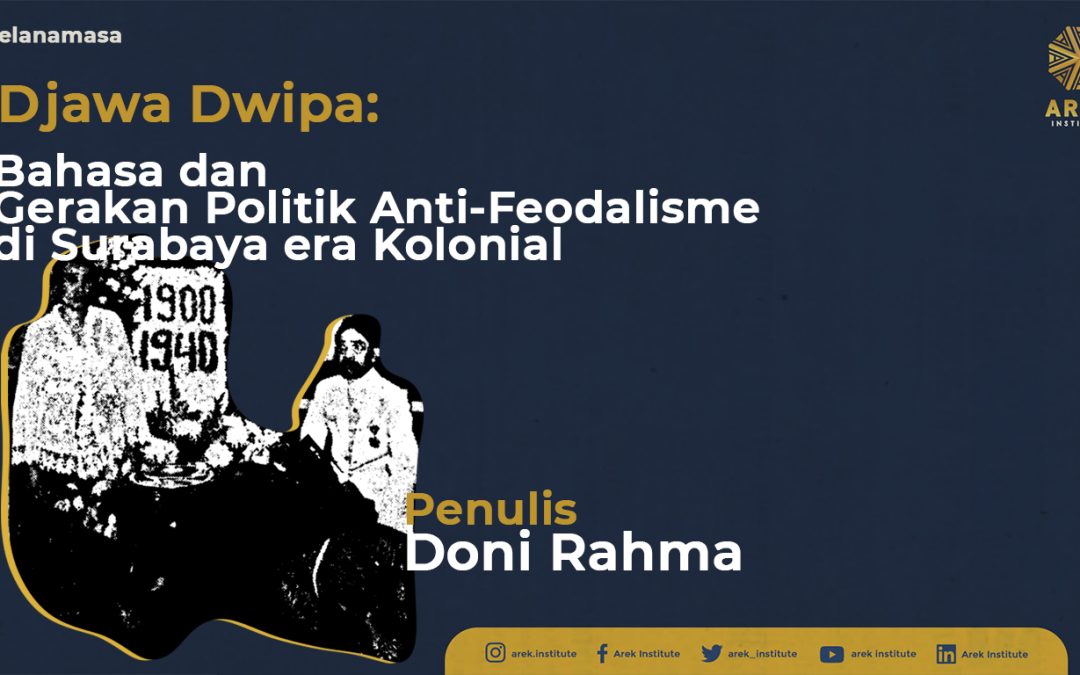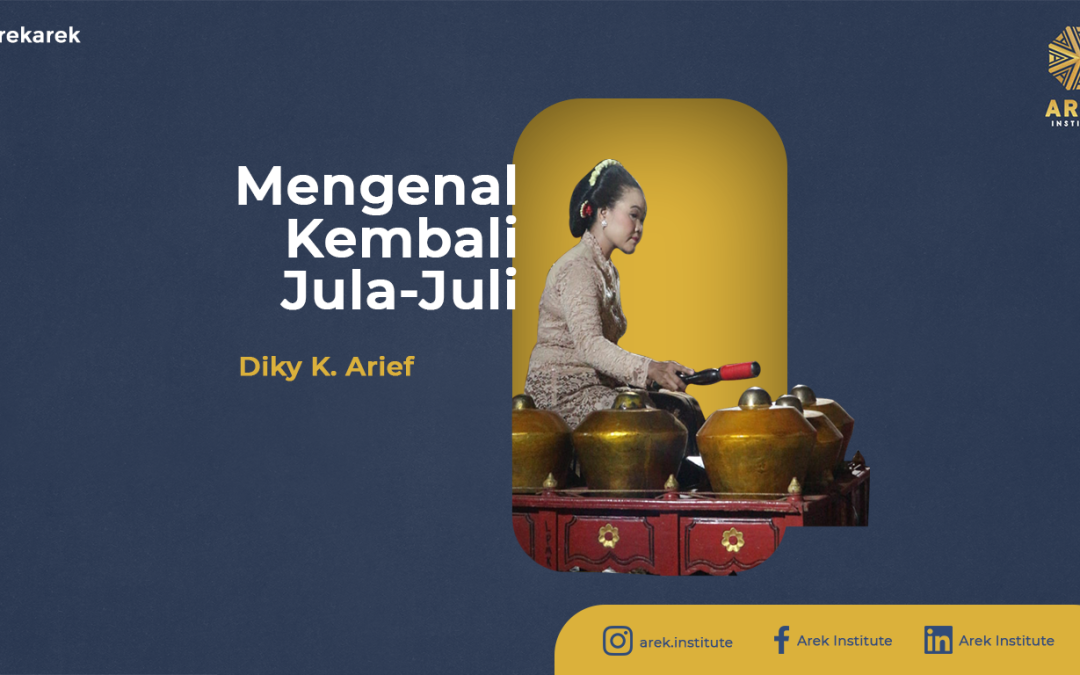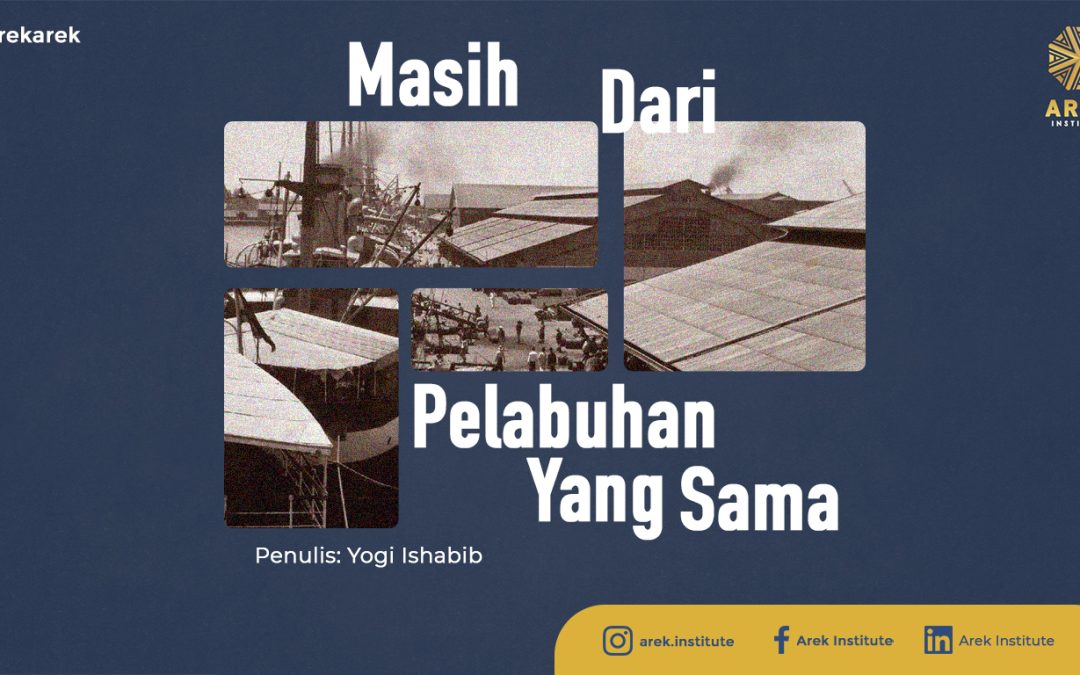
by Penelitian Arek | Sep 4, 2025 | Kelana Masa

Doni Rahma | Anthropology FISIP Unair Student | Arek Institute Researcher Network
Almost 100 years ago, on March 11, 1917, in Surabaya, a movement called Djawa Dipa was born, opposing the feudalistic practices of the time. According to various records, the movement was first initiated in two locations: the Oost Java Bioscoop building (now a shopping complex in the Aloon-aloon Contong area) and the Oost JavaRestaurant. From its inception, Djawa Dipa aimed to equalize the use of the Javanese language by abolishing its hierarchical structure. In other words, unggah-ungguhing basa (the stratified levels of Javanese language such as ngokoand krama) had to be eliminated. The Krama class, referring to the lower layers of Javanese society, became the movement’s main focus because equality for them was of utmost importance. Until then, the hierarchy in the use of the Javanese language had only widened the gap of social stratification and reinforced unfair treatment against them (Thamrin, 2022).
One of the key figures behind the birth of Djawa Dipa was Tjokrosoedarmo, the leader of the SI (Sarekat Islam) Surabaya branch — a native arek Suroboyo from the Plampitan neighborhood, who came from a priyayi (noble) family background. However, in contrast to his aristocratic origins, he became a vocal critic of the rules governing the use of krama (high-level Javanese language). For him, a language structure built on rigid hierarchy was not a tool for communication, but rather a wall of oppression — something that burdened the Javanese people. This was evident in a fragment of his radical ideas, delivered during a speech at the formation of the Djawa Dipa committee, which was also published in the Sinar Djawa newspaper, March 15, 1917 edition.
”…telah njata kita ketahoei, sampai saat ini, dan sampai zaman perobahan ini, atoeran bahasa Djawa ”kromo” itoe hanjalah membikin soesah kita Djawa sadja. Berlantaran atoeran bahasa Djawa ”Kromo” itoe tidak sedikit bilangannya…Maka ketjelakaan dan kesengsaraan pendjara itoe bagi kita boekan bangsa ”sastrawan” hanjalah lantaran soesahnja atoeran bahasa Djawa ”kromo” ada di moeka persidangan hakim”
(…it is clear to us, even up to this moment, and into this era of change, that the rules of the Javanese ‘krama’ language only bring hardship to us Javanese. Because of these ‘krama’ language rules—of which there are no small number… Misfortune and the suffering of imprisonment for us, who are not a ‘literary’ people, are merely caused by the difficulty of these ‘krama’ rules when faced in front of the judge’s court.)
In its time, Djawa Dipa appeared to be supported by prominent figures, including Tjokroaminoto of Sarekat Islam itself. Although Tjokroaminoto was initially not very enthusiastic about the emergence of Djawa Dipa, as the movement gradually expanded in 1918 and his dominance within Sarekat Islam (CSI) began to wane, he quickly moved to consolidate new forces. Djawa Dipa was then promoted and pushed to become a militant movement aimed at transforming the “slave mentality” of the Javanese people (Siraishi, 1997).
As a movement, Djawa Dipa often directly issued appeals encouraging the reduction of krama (high-level Javanese) usage. One of its early recommendations included changing honorifics or forms of address: using “Wiro” for men, “Woro” for married women, and “Liro” for unmarried women (Thamrin, 2022). The movement also expanded to include calls for rejecting long-standing gestures of deference embedded within the Dutch East Indies bureaucracy. These gestures included a wide range of social behaviors, dress codes, hierarchical language use, and honorary titles.
Javanese people were required to treat Dutch officials with elaborate forms of submission: walking in a crouched or squatting position (jongkok), addressing colonial officers as kanjeng tuan, sitting cross-legged in their presence, and performing a respectful gesture of placing both hands against the upper lip (sembah) after the officials spoke (Der Meer, 2021).
Although Djawa Dipa was enthusiastically welcomed by the Javanese public and became a topic of discussion in various newspapers at the time, its presence also brought with it the consequence of skepticism about its effectiveness in leveling the Javanese language. This view emerged from the conservative elite, who felt that their power was being threatened by the rise of Djawa Dipa. This sentiment was evident, for instance, in a column published in De Indier on April 10, 1917. The author of the piece was not clearly identified, but the tone of the writing revealed a skeptical attitude toward the presence and aims of Djawa Dipa.
”De ngoko-questie houdt de gemoederen in de inlandsche wereld nog warm. Er is bereids een vereeniging gevormd onder den naam Djawa Dipa, die het ngoko zal trachten vereheffen tot algemeene tal op Java. Wij staan er zeer sceptisch tegenover!”
(The ngoko question continues to stir emotions in the inlander. An association has already been formed under the name Djawa Dipa, which will attempt to elevate ngoko to the status of a general language in Java. We view this with great skepticism!)
There was also a lengthy opinion piece titled “Djowo Dipo Contra Adat” (“Djawa Dipa Against Custom”) written by a district head (the specific region was not detailed), published in the De Locomotief newspaper on June 14, 1921. In it, he expressed his concerns about the growing presence of Djawa Dipa, which he viewed as increasingly troubling.
According to him, the Djawa Dipa movement was seen as undermining the authority of the priyayi (Javanese aristocracy). This colonial official considered the use of informal terms like “Kowe” (you, in low-register Javanese) when addressing officials to be an insult to the established customs and power structures.
Although he did not deny that real change was happening, he insisted that politeness must remain paramount. He cited an incident in which a wedana (district head) was approached by two members of Djawa Dipa as an example of this perceived breach of decorum.
”…De wedono liet zich niettemin door die woorden niet van streek brengen, bleef kalm en vroeg den heeren gemoedelijk in het hoog-Javaansch: ‘Sampean wonten perloe poenopo?’ (Wat is er van uw dienst?”
(…The wedana, however, was not shaken by those words, remained calm, and politely asked the gentlemen in high Javanese: ‘Sampean wonten perloe poenopo?’What can I do for you?’)
Despite all of that, Djawa Dipa chose to remain actively vocal. To facilitate the wider dissemination of their propaganda, in April 1921 they finally launched the first issue of their weekly newspaper titled Hindia Dipa (Thamrin, 2022).
The release of the newspaper appears to have been accelerated compared to the original plan. This differed from a report in the Nieuwe Rotterdamsche Courant dated March 22, 1921, which had stated that Hindia Dipa would be published at the end of 1921.
On the other hand, Hindia Dipa, as the media outlet of Djawa Dipa, chose to use a blend of Malay-Javanese as its primary language.
Language as a revolutionary medium
During the 19th century, the Dutch systematically indoctrinated themselves into Javanese society through a process of cultural appropriation that legitimized their authority. This legitimacy was heavily dependent on the preservation of the culture of the traditional elite. The Dutch deliberately created cultural hegemony by adopting and institutionalizing Javanese-style rituals. Symbols of power—such as hierarchical forms of dress, lifestyle, language, consumption, and architecture—were carefully maintained and reinforced by the colonial regime (Der Meer, 2019).
Clifford Geertz, in his book Negara: The Theatre State in Nineteenth-Century Bali, also explained that state power is not only embodied in institutions but also in the continuous production of symbols. In other words, symbols are not merely matters of aesthetics—they are manifestations of power itself.
All of this gradually began to shift. The early 20th century marked a transformative period of social and cultural change. The Dutch Ethical Policy, though intended as a colonial reform, inadvertently created the conditions for the emergence of indigenous movements that became increasingly critical of all forms of feudal relations with the colonial power (Der Meer, 2021).
It was within this context that history records the rise of a radical movement in Surabaya that opposed state domination—particularly as it related to language hierarchy. As noted by J. P. Zurcher, although traditional customs were still respected, the times had changed significantly. The Javanese people of the past were no longer the same as those of the present. They had evolved, and with that evolution came a naturally emerging spirit of resistance.
DAFTAR PUSTAKA
Der Meer, A. (2019). Igniting Change in Colonial Indonesia: Soemarsono’s Contestation of Colonial Hegemony in a Global Context. Journal of World History, 30(4), 501–532.
Der Meer, A. (2021). Sweet Was the Dream, Bitter the Awakening: The Contested Implementation of the Ethical Policy 1901-1913. In Performing Power: Cultural Hegemony, Identity, and Resistance in Colonial Indonesia (pp. 48–76). Cornell University Press.
Districtshoofd. (1921, June 14). Djawa Dipa Contra Adat. De Locomotief.
Djawa Dipa. (1917, April 10). De Indier.
Geertz, C. (2017). Negara Teater: Kerajaan-Kerajaan di Bali Abad Kesembilan Belas. BasaBasi.
Java en Madoera. (1921, March 22). Nieuwe Rotterdamsche Courant .
Siraishi, T. (1997). Zaman Bergerak: Radikalisme Rakyat di Jawa 1912-1926. Pustaka Utama Grafiti.
Thamrin, M. H. (2022). Djawa Dipa: Sama Rata, Sama Rasa, Sama Bahasa 1917-1922 (1st ed.). Komunitas Bambu.
Zurcher, P. J. (1920). De Indische Gids (Vol. 42). J. H. de Bussy.

by Penelitian Arek | Feb 13, 2025 | Arek-Arek

Diky K. Arief | A student of Islamic Theology and Philosophy at the State Islamic University of Surabaya[]
When East Javanese traditional art is discussed, the main spotlight often falls on Ludruk—a performing art that has long been a cultural pride of the arek-arek (young people) community. However, behind the vibrant discussions about Ludruk, there is one crucial element that is often overlooked by the media and cultural discourse: Jula Juli. Without Jula Juli, Ludruk would not feel complete.
Jula Juli is not merely a part of the East Javanese kidungan (traditional sung poetry); it is a literary form that records the long history of its people. Within each song performed, there are narratives about anxiety, hope, humor, social criticism, and the daily lives of Javanese society, particularly in Surabaya and the broader Arek subculture regions.
Varieties of Jula Juli
Jula Juli and Ludruk are always intertwined with traditional art in East Java. As part of a Ludruk performance, Jula Juli serves as an introduction or accompaniment that breathes life into the show. However, Jula Juli does not entirely depend on Ludruk as its medium. As an independent art form, Jula Juli can be performed outside of Ludruk shows.
To trace the connection between Jula Juli and Ludruk, let us briefly explore its historical emergence. There are several versions of how Ludruk and Jula Juli originated. One story states that Ludruk was initially created by a farmer named Santik from Ceweng Village, Diwek District, Jombang Regency. In 1907, Santik, along with his two friends, Pono and Amir, performed Jula Juli from one hamlet to another while wearing makeup resembling women, which they found amusing. They then sang Jula Juli in a humorous style to entertain the public (Ismail, 2023).
Another story claims that Ludruk had already developed as early as 1890, but it was not introduced by Santik. Instead, a street performer named Gangsar from Pandan Village, Jombang, was credited with its emergence. His story closely resembles Santik’s role in pioneering Ludruk, which at the time still took the form of Lerok. According to the tale, Gangsar and his friends were performing when they encountered a crying baby being held by a man. Upon closer observation, the man had adorned himself like a woman, hoping to deceive his child into thinking they were being cradled by their mother. Inspired by this, Gangsar and his friends began performing with makeup that made them look like women. This story is also considered one of the key reasons behind the emergence of the travesti (cross-dressing) tradition in Ludruk performances (Soenarno, 2023). The final version suggests that Ludruk began to develop in Surabaya.
Unfortunately, these stories focus solely on the origins of Ludruk, while the emergence of Jula Juli remains largely undocumented. However, the development of Jula Juli has always been closely linked to Ludruk. Over time, Jula Juli started to expand its reach, evolving into an independent art form separate from Ludruk. In Jula Juli, the sung poetry follows a pattern similar to pantun (traditional rhymed verses), delivered with vocal techniques and accompanied by gending (traditional Javanese music). The narration is presented in the rough, colloquial ngoko dialect of East Javanese speech.
Regional Variations of Jula Juli
As Jula Juli evolved, it developed unique regional characteristics across East Java, adapting to the socio-cultural contexts of different communities. These variations include Jula Juli styles from Surabaya, Pandalungan, Jombang, and Malang (Setiawan, 2017). While all these variations retain similar musical patterns and accompaniment styles, each version presents a distinct atmosphere and character, particularly in linguistic aspects.
The diversity of Jula Juli has given rise to its own historical narratives in different regions. It reflects the cultural, social, and political conditions of its time. For example, in Jombang, a Jula Juli style developed using the slendro Pathet Wolu scale. This scale was performed during Bapang Wayang Topeng Jatiduwur performances (Annur, 2022). However, there is neither historical evidence nor folklore detailing the origins of Jula Juli in the slendro Pathet Wolu scale. Nevertheless, Wayang Topeng Jatiduwur has existed since the Majapahit era during King Hayam Wuruk’s reign and was later revitalized by Ki Purwo in Jatiduwur Village, Kesamben, Jombang.
Beyond Jombang, around 2014 in Malang, a new musical style emerged under the name Jula Juli Lantaran Gaya Malang. This style was pioneered by Sumantri, who created it in response to the limitations of previous macapat song styles (Pamuji, 2017). The distinction lies in its musical characteristics: Jula Juli Lantaran Gaya Malang incorporates elements of macapat with rhythmic arrangements highlighting Kendang Kalih and Gambayak drumming techniques (Pamuji, 2017). This marks a unique feature not found in conventional Jula Julicompositions.
Unlike the Malangan or Jombangan styles, Jula Juli Madura has a history closely tied to the socio-political dynamics of the Dutch colonial era. This version of Jula Juli was born as a product of its time, shaped by the cultural assimilation between Madurese and Javanese communities under Dutch colonial racial policies. The Dutch anthropologist Huub de Jonge documented colonial-era stereotypes about the Madurese people, portraying them as “backward” and “harsh-tempered”—both of which reflect colonial biases. This narrative reinforced the discriminatory perspectives of colonial rule, further stigmatizing the Madurese in the eyes of both the colonizers and surrounding Javanese communities.
The presence of the Madurese people was often positioned as “the other.” Their voices remained faintly heard. This historical backdrop of stereotyping led Jula Juli Madura to become a unique form of resistance against systematic subjugation by colonial systems and knowledge structures (Setiawan, 2017).
This defiance is also reflected in kèjhungan gending Yang-Layang, a distinctive kidungan (sung poetry) from Madura influenced by Javanese kidungan and the adaptive evolution of Jula Juli. However, its uniqueness lies in its high-pitched and melancholic cengkok(melodic ornaments), symbolizing the Madurese people’s strong sense of dignity, outspokenness, and migratory nature (Mistortoify, 2015). One example of kèjhungan Yang Layang is as follows:
“Sampang roma sakè translation: Sampang (has) hospital
Tuan dokter acapèngan potè The doctor wears white hat
Lo’ ghãmpang dhãddhi rèng lakè’ It is not easy to be a man
Mon lo’ pènter nyarè pèssè” If cannot earn money
(Mistortoify, 2015)
Through the Jula Juli they created, they not only expressed their cultural identity but also demonstrated resistance against the stereotypes that had long been imposed upon them.
The migration of the Madurese people to the Tapal Kuda (Horseshoe) region also gave rise to a unique Jula Juli style known as Pandalungan. Pandalungan refers to Madurese communities born in Java who have assimilated with Javanese culture while living in the Tapal Kuda region, which includes Jember, Situbondo, Probolinggo, and Lumajang (Satrio, 2020).
This migration can be traced back to the 18th century, specifically in 1870, when the Dutch colonial government enacted more agrarian policies that allowed private enterprises to expand their economic activities in East Java. As a result, rubber, sugarcane, and tobacco plantations began to emerge, and low-wage laborers were brought in from Madura to work on them (Akhiyat, 2023). However, this was nothing more than a colonial strategy to perpetuate slavery. The Dutch forcibly employed enslaved laborers on plantations—bringing slaves from Java to work on land in Sumatra and from Madura to work on land in Java. By sourcing enslaved workers from regions separated by the sea, they ensured easier control over them (Setiawan, 2017).
As a result, cultural assimilation occurred in the inclusive Tapal Kuda region, giving birth to distinctive traditions—one of which is Jula Juli Pandalungan/Pendalungan. This particular Jula Juli is often performed in Jaran Kencak (a traditional horse dance) performances and is incorporated into the Napel/Sumpingan segment. In this segment, a guest sings Jula Juli to the host while presenting monetary offerings (saweran) to the Remo dancer as a gesture of respect to the host (Juwariyah, 2023).
In her writings, Nura Murti compiled Jula Juli/kèjhungan from the Pandalungan tradition in Jember Regency, highlighting the values of cultural assimilation in the Tapal Kuda region (Murti, 2017), such as the following example:
“Tanem magik tombu sokon terjemahan: planting Tamarind grows breadfruit
tabing kerrep benyyak kalana A tightly woven bamboo was full of scorpions
mompong gik odik koddhu parokon As long as one is alive, harmony must be maintained
ma’ olle salamet tèngka salana” To stay safe in one’s behaviour
The various types of Jula Juli demonstrate that music and culture are not merely forms of entertainment but also serve as tools for expressing identity, worldview, and even dissatisfaction with prevailing social conditions. Like other traditional arts, Jula Juli stands as a silent witness to how culture becomes an arena of struggle—where narratives of oppression can be transformed into songs that inspire and unite people from diverse walks of life.
Jula Juli as a Medium of Social Resistance and Propaganda
During the colonial period, Jula Juli evolved into a medium for criticizing the Japanese colonial system, infused with elements of satire. For example, in one of the most renowned kidungan (traditional sung poetry) pieces by Cak Durasim, sharp criticism was directed at Japanese rule, which had further worsened the conditions of the indigenous people, as cited in Setiawan’s (2021) article:
“A dovecote is a home for doves,
Following the Japanese only brings suffering.
Bought klepon at the station,
Following the Japanese means no pension.”
The first two lines of the verse are also inscribed on Cak Durasim’s tombstone at Tembok Gede Cemetery in Surabaya, serving as a lasting reminder that local arts and culture—such as Ludruk and Jula Juli—have functioned as tools of resistance. Jula Juli was not merely an art form; it was a means of challenging the status quo of its time.
Beyond being a vehicle for social criticism, Jula Juli was also used as a medium for propaganda. During the Guided Democracy era of the late 1950s, political parties frequently utilized this art form to convey ideological messages from various political groups. This is evident from the fact that many political parties had autonomous cultural organizations within them. Some of these included the Indonesian National Party (PNI) with its National Cultural Institute (Lembaga Kebudayaan Nasional—LKN), the Indonesian Communist Party (PKI) with its People’s Cultural Institute (Lembaga Kebudayaan Rakyat—Lekra), Masyumi with its Islamic Arts and Culture Association (Himpunan Seni Budaya Islam—HSBI), and the Catholic Party with its Catholic Indonesian Cultural Institute (Lembaga Kebudayaan Indonesia Katolik—LKIK) (Susanto, 2017).
The presence of multiple political streams and ideologies made culture an arena for ideological battles and influence. Art and literature, as part of culture, were often used as mediums to convey ideological messages, either explicitly or implicitly. This even led to the notion that “whoever wins has the right to write history” (Susanto, 2017).
This was no exception for Jula Juli and Ludruk. The proliferation of Ludruk groups in East Java turned the art form into a political battleground, resulting in the emergence of two major factions: Ludruk supporting the PKI and Ludruk supporting the PNI. When these two factions performed on neighboring stages, it was not uncommon for them to engage in ideological duels through Jula Juli performances (Setiawan, 2021).
“Budal tandur, muleh njaluk mangan “Jumat legi nyang pasar genteng
Godonge sawi, dibungkus dadi siji Tuku apel nang Wonokromo
Ayo dulur, podho bebarengan Merah putih kepala banteng
Nyoblos partai, partai PKI” Genderane dr. Soetomo”
That Jula Juli verse is one example of how traditional art was utilized by political parties to subtly convey their ideological messages. With its colloquial language and a rhythm familiar to the people of East Java, political propaganda was woven into the lyrics of the kidungan(chant). In this way, Jula Juli transformed into an effective political communication tool, reaching various segments of society that might not be accustomed to formal political narratives. However, kidungan and Ludruk performances associated with the PKI began to fade following the events of September 30. That incident marked a period of silence and the disappearance of Ludruk from the national stage (Setiawan, 2021).
At that time, the New Order regime did not only suppress the PKI physically but also sought to dominate culture associated with it. The Pengkhianatan G30S/PKI (The Treachery of G30S/PKI) film, produced by the regime, was widely disseminated, books deemed to contain leftist ideology were banned and removed from circulation, and traditional arts were tamed by the regime to steer literature toward “safe” storytelling (Restu, 2020). One of the affected art forms was Ludruk. As a form of folk art closely tied to narratives of the people and resistance, Ludruk was considered dangerous. During that era, both Ludruk and Jula Juli, as part of Ludruk, temporarily lost their voices.
The Revitalization of Jula Juli in the Contemporary Era
Amid the influence of both Western and Eastern cultures today, this tradition faces the challenge of staying relevant in an era of modernization. The name Cak Kartolo, a legendary Ludruk Suroboyoan maestro, is often credited with playing a significant role in revitalizing Jula Juli, ensuring its survival and acceptance by modern audiences.
Cak Kartolo recorded his Ludruk performances on cassette tapes, which were then widely distributed across East Java. He became well-known for delivering Jula Juli with a comedic style rich in humor. In every recording, he was always accompanied by the karawitan(traditional Javanese musical ensemble) group Sawunggaling (Mukaromah, 2018).
Apart from Sawunggaling with Cak Kartolo, during the same period, Cak Sulabi and his Ludruk group Budhi Wijaya also gained recognition for their popular Jula Juli Suroboyoan, such as the following Jula Juli:
“Mulone jok gampang dulur peno dipecah belah
mundhakno sing seneng kaum penjajah
sopo sing salah dulur kudu podo ngalah
supoyo persatuan kito gak gampang blubrah”
Moreover, Jula Juli continues to reinvent itself by addressing more contemporary issues. For example, in the field of education, Jula Juli is used to teach moral values, history, and even social skills. One such example is the following kidungan:
“Sugeng enjang salam literasi
Anak-anakku sayang kabeh sing tresnani
Ayo belajar gawe mbangun negeri
Iki wawasan tekan sekolah yo dipelajari (Primaniarta, 2022).”
Through Jula Juli, this art form not only reintroduces East Javanese cultural identity to the younger generation but also serves as a medium for character building and fostering social awareness. Therefore, tracing the values and knowledge embedded within Jula Juli can be seen as a form of cultural archaeology within the subculture of East Java.
References
Ismail dan Asih Widiarti, “Pentas Ludruk yang Menolak Mati,” TEMPO Publishing, 2023.
Aris Setiawan, Suyanto Suyanto, dan Wisma Nugraha Ch. R., “Jula-Juli Pandalungan dan Surabayan Ekspresi Budaya Jawa-Madura dan Jawa Kota,” Resital: Jurnal Seni Pertunjukan 18, no. 1 (2017): 1–12
Aris Setiawan, “Kidungan Jula-juli in East Java: Media of Criticism and Propaganda (From The Japanese Occupation Era to The Reform Order in Indonesia),” Harmonia: Journal of Arts Research and Education 21, no. 1 (7 Juni 2021): 79–90.
Muhammad Akbar Darojat Restu Putra, “Membaca Lagi ‘Kekerasan Budaya,’” Islam Bergerak (blog), 2020
Gita Primaniarta dan Heru Subrata, “Development of Kidung Jula-Juli as a media for children’s literacy,” Premiere Educandum : Jurnal Pendidikan Dasar dan Pembelajaran 12, no. 2 (2022): 1–13
Bima Atyaasin Annur, Setyo Yanuartuti, dan I. Nengah Mariasa, “Characteristics of Gending Jula-Juli Laras Slendro Pathet Wolu in The Bapang Dance Jombang Jatiduwur Mask Puppet,” Virtuoso: Jurnal Pengkajian dan Penciptaan Musik 5, no. 2 (2022): 142–47.
Iska Aditya Pamuji, “GARAP GENDING JULA-JULI LANTARAN GAYA MALANG,” KETEG: Jurnal Pengetahuan, Pemikiran, dan Kajian Tentang “Bunyi” 17, no. 2 (2017): 69–79.
Sonarno, Sejarah Ludruk (Semarang: Mutiara Aksara, 2023.).
Anik Juwariyah, “The Study of Panji Culture in the Pandalungan Sub-ethnic, East Java Review: Jaran Kencak Performing Art,” Atlantis Press, 2023.
Dwi Susanto, Lekra VS Manikebu (Sejarah Sastra Indonesia periode 1950- 1965) (Yogyakarta: CAPS (Center for Academic Publishing Service), 2017).
Axzella Raudha Mukaromah, “Proses Kreatif Cak Kartolo dalam Jula-Juli” (skripsi, Yogyakarta, Institut Seni Indonesia Yogyakarta, 2018).
Prakrisno Satrio, Suryanto Suryanto, dan Bagong Suyanto, “MASYARAKAT PENDALUNGAN (Sekilas Akulturasi Budaya di Daerah ‘Tapal Kuda’ Jawa Timur),” Jurnal Neo Societal 5, no. 4 (2020): 440–49.
Akhiyat dan Amin Fadlillah, “SEEKING THE HISTORY OF PENDALUNGAN CULTURE: A DISTINCTIVE STUDY OF LOCAL CULTURAL HISTORY IN THE HISTORY AND ISLAMIC CIVILIZATION PROGRAM OF UIN KHAS JEMBER,” Jurnal As-Salam 7, no. 2 (22 Juli 2023): 276–99.
Zulkarnain Mistortoify, “ONG-KLAONGAN DAN LÈ-KALÈLLÈAN ESTETIKA KÈJHUNGAN ORANG MADURA BARAT” (Yogyakarta, Universitas Gadjah Mada, 2015).
Fitri Nura Murti, “Pandangan Hidup Etnis Madura dalam Kèjhung Paparèghân,” Istawa : Jurnal Pendidikan Islam 2, no. 2 (2017).





